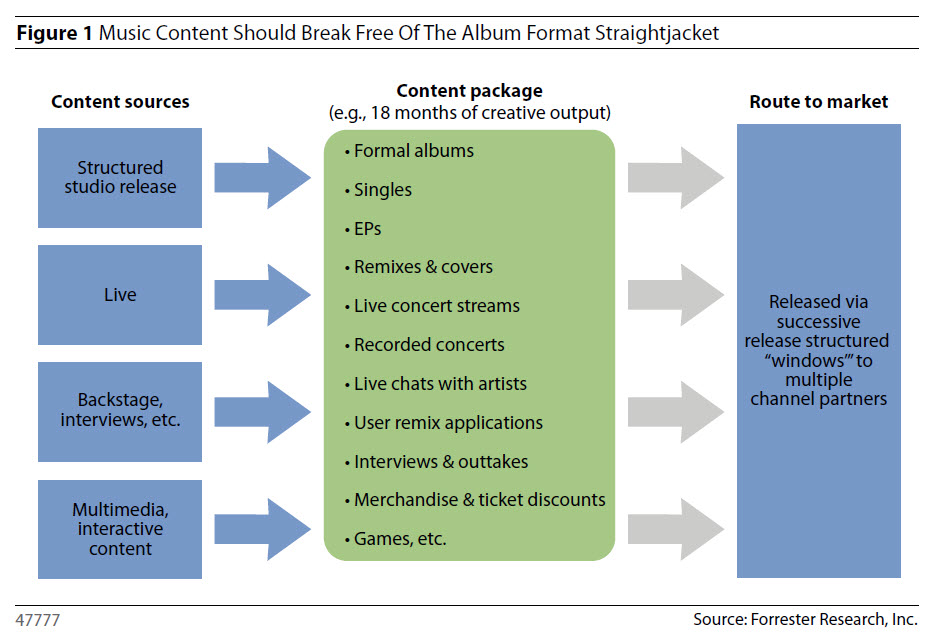 Last week, Forrester Research relased their report, “Music Release Windows: The Product Innovation That The Music Business Can’t Do Without” by Mark Mulligan. The report verifies the obvious, but makes some very valid points that are worth jotting down.
Last week, Forrester Research relased their report, “Music Release Windows: The Product Innovation That The Music Business Can’t Do Without” by Mark Mulligan. The report verifies the obvious, but makes some very valid points that are worth jotting down.
The good news is, “more people are listening to more music with more technology than ever before”. The bad news is our inability to monitieze these technologies. The 99 cent download has kept consumers happy while they ditch thier CD collections, however, it has yet to provide enough money to balance the record label’s checkbook. Not a good sign for you, the artist, who has chosen this profession above all other things. Fortunatley for us, Forrester thinks they may have the answer to all of our problems. I’ll let you be the judge.
Below are the three product innovations that Forrester wants record labels of all shapes and sizes to implement:
- Leverage diverse content assets - The major labels — and even Live Nation — got bad press for pursuing “360 deals” with artists, but they present an unprecedented ability to tap into a much wider range of artist assets than ever before.4 We want to see these assets explicitly leveraged and productized. Artist managers have become adept at helping their artists develop rich portfolios of non-label “assets” that they can use with third parties.5 These are great skill sets that labels, managers, and artists will be able to nurture together as partners to create a rich tapestry of creative output.
- Moves from releases to relationships - In the digital age, there is no need to release 12-track bundles of music. In fact, in the consumption era, album releases put speed bumps in the continual artist-fan relationship. Back in the 1980s and early 1990s, artists often used EPs to sustain creative output outside of album release schedules. In some respects, it is time for “back to the future.” We want to see labels empower artists to think outside of the confines of the album and maintain steady, continual streams of creative output. Of course, it makes sense to have some structure in this process, and in fact, albums can still be part of the mix, particularly for the artists whose audiences are primarily CD buyers. But the crucial point is a continual stream of creative output, of which standard studio work will just be one element, complemented by extensive additional content (see Figure 1). Apple and EMI’s Depeche Mode iTunes Pass is a great start, but we want to see more — much more.
- Establish structured release windows that communicate value - The proliferation of new music services makes it difficult for consumers to discern any one service’s relative position in the product range and to understand value and premium. We’d like to see record labels take a leaf out of the book of movie studios and implement structured release windows. Releases would start at the top of the release cycle and progressively work down through lower tiers. We also think that the new content assets should be saved for higher product tiers: You’re creating new, extra value, so save it for the music fans who are willing to pay for it. Think of it as their reward for being high-value customers. There are, of course, numerous challenges associated with establishing release windows, but we simply don’t believe that digital innovation can deliver the requisite results without such a framework being in place.
I’m sure my experience within the music business is similar to many of yours. We claim to be Indie/ DYI until the record label writes a check. If we all banded together, as we do everyday on sites like this, we could beat the labels to the punch. Invent a product, service or technology that ileviates the pain in our process. Beating the majors at their own game is my purpose. What is yours?
Kevin English is a marketer and student of the arts, who blogs about the skills and strategies necessary to get the most of your musical career at http://eleetmusic.com or on Twitter @eleetmusic.